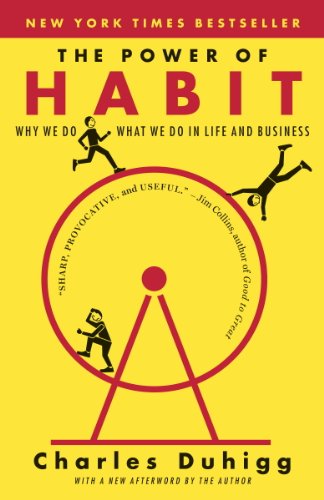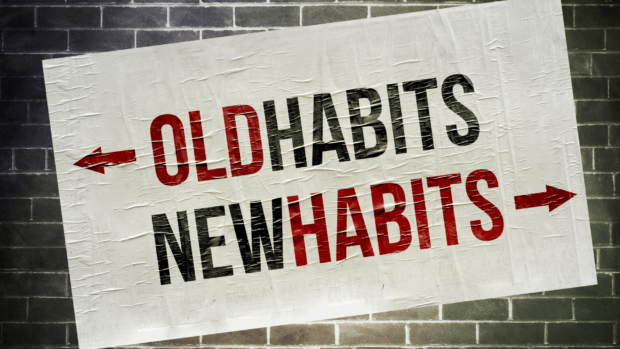Bad habits can prevent you from accomplishing your goals and put a dent in your productivity. They steal from your health — both mentally and physically. And they drain your time and energy.
Habits become hard to break the longer you allow them to stick around because they become deeply wired in our brains through constant repetition. When you add pleasure to them — like you have with fast food or porn, for example — the pleasure creates the cravings that folks struggle with.
So when going through your morning routine, driving to work, or walking the dog, you probably don’t have to think very much. That’s because you’ve done this task so many times it has become a pattern, and your mind puts it on autopilot.
Many cannot accept that the results they are reaping today are the sum of what they repeatedly do. No wonder only a few benefit from the power of habits.
Here are some hacks that allow you to start benefiting from the power of habits rather than being held back by your bad habits:
Replace Bad Habits Rather than Eliminating Them
Habits form because they provide a benefit. In the case of bad habits, that benefit is outweighed by the consequences, but it’s there still the same. For example, smoking provides the benefit of feeling good and satisfying a craving.
The damage it causes is far more significant than the benefits that it provides, but those benefits can still be hard to let go of. Instead of eliminating a bad habit, your focus should be on replacing that bad habit with something that provides the same or similar benefits without all of the drawbacks.
In the case of smoking, many people use nicotine patches, nicotine gum, or even vaping to still achieve the benefit of smoking while at the same time breaking the habit. The same strategy can be used for any bad habit.
Once you identify the benefits that your bad habit is providing – the benefits that make the habit so hard to break – find things that can offer the same benefits without all of the drawbacks. Replacing a bad habit in this manner is much easier than eliminating a bad habit with no replacement.

The Power of Habit
By Charles Duhigg
⏱ 10 minutes reading time
🎧 Audio version available
Get Rid of Triggers
Most all bad habits have triggers that push you toward them.
For example, if you have a bad habit of over-eating, a refrigerator full of junk food is going to serve as a very obvious and powerful trigger for your bad habit.
The best thing you can do to break a bad habit is to get rid of its triggers. Identify the things that push you toward a bad habit and eliminate them.
You’ll find that eliminating a bad habit’s triggers is much easier than eliminating the habit itself while still helping you break the habit over time.
Consider Negative Reinforcement
Several years ago, an entrepreneur appeared on the popular reality show “Shark Tank” to pitch an invention designed to help people break bad habits.
His invention was a bracelet that would deliver a small but certainly noticeable electric shock to the wearer’s forearm whenever they participated in a bad habit that they were trying to break. Of course, this invention isn’t the first concept of using negative reinforcement to break bad habits.
Long before this product was brought to market, many people would place a rubber band around their wrist and pop themselves with it anytime they indulged in a bad habit. Whether or not you decide to physically punish yourself in a manner such as this is up to you.
However, there is something to be said about the effectiveness of negative reinforcement in breaking bad habits. In the same way that positive reinforcement rewards and reinforces positive behaviors, negative reinforcement punishes, and discourages negative behaviors.
If you don’t feel like shocking yourself or flicking your wrist with a rubber band, simply giving yourself a good scolding each time you participate in a bad habit you are trying to break may be enough to do the trick.
It won’t be pleasant, but associating bad habits with unpleasant things is certainly a great way to make them far less enjoyable subconsciously.
Focus on Your “Why”
For every bad habit, there is at least one good reason why you should want to break it. After, if a habit does not have any negative consequences, it really can’t be considered a bad habit.
If you’ve determined that a habit of yours is bad, though, then you should have no trouble finding reasons why your life would be better if you left this habit behind.
These reasons are your “why” – why you want to break this particular habit and why you feel that you will be better off once you can leave it behind. Rather than focusing on the habit itself, focus on these reasons why you should break it.
Use them as your motivation and think of them often so that they can serve as a constant reminder of how much better off you will be once you can break your bad habits once and for all.
Leave Yourself Reminders
In many cases, the thing that leads people to continue indulging in their bad habits even when trying to break them is simple forgetfulness.
Habits are habits because they become second nature – things you do without even thinking about it while doing them. With this being the case, one great way to avoid falling back into a bad habit for the simple reason that you forget to avoid it is to leave yourself reminders.
For example, if you are trying to break a habit of drinking too much soda, leaving a note on the refrigerator to remind yourself of this goal each time you open it is one option to consider. Another great idea is to make use of your smartphone and its ability to send you reminders.
For instance, if you are trying to break the habit of not exercising and spending too much time lounging around, set a reminder on your phone to go for a walk so that it will send it to you as a notification at various intervals throughout the day.
However, you go about it, leaving yourself reminders not to indulge the bad habits that you are trying to break is an excellent way to avoid falling back into those habits for the sole reason that you forgot to avoid them.
Related: 7 Most Common Reasons Why People Don’t Stick with New Habits
Avoid Temptation
There’s a concept known as “the path of least resistance,” which dictates that people are much more likely to do that which is easier and offers less resistance regardless of how desirable it may or may not be – and this is a concept that heavily applies to the goal of breaking bad habits.
Consider, for example, an alcoholic who is trying to give up drinking. Now, this is a challenging goal to achieve, no doubt, but it is a goal that is going to be exceedingly more difficult when that person is hanging out at a bar than it is when they are hanging out at the gym.
In other words, avoiding temptation and ensuring that indulging your bad habits is not the path of least resistance is essential if you want to avoid the pitfalls that will lead you to fall back into your habits. You should make it as difficult to indulge your bad habits if you want to break them.
If you’re trying to avoid eating junk food, for example, make sure that there isn’t any available in your home. Don’t even go down the snack food or chips aisle at the grocery store next time you go shopping.
Avoid temptation, make sure that your bad habits are not readily available for you to indulge the next time you get the urge, and you are sure to have a much easier time avoiding them.
In a way, this strategy for avoiding bad habits is a little like using laziness in your favor. When you make it as difficult as possible to indulge in bad habits, their temptation becomes a lot less strong
Recruit an Accountability Partner
Peer pressure isn’t always a negative thing. Sometimes, a little pressure from your peers can push you in a positive direction.
Recruiting an accountability partner to help you break your bad habits is one way to put the positive aspects of peer pressure to work.
Having an accountability partner gives you a powerful source of motivation.
Not only will you be letting yourself down, if you fall off the wagon and go back to a bad habit
Many times, we’re even more bothered by disappointing someone else than we are by disappointing ourselves. If your accountability partner is struggling with the same habit that you are then that’s all the better – you can both work to help each other break the habit.
It’s not a requirement, though, and anyone that you trust and think highly of can serve as an accountability partner.
Make Use of Visualization
Visualization is a powerful mental tool.
It can be used to help you reach any goal, including breaking a bad habit. Each day, take the time to visualize yourself breaking the habit.
Visualize what it will take for you to let go of the habit and visualize the way in which your life will improve once you do.
This can serve as an effective source of motivation if you do it enough.
We all have that habit we’re trying to shake.
Whether it’s biting your nails, snacking at night, overspending your budgets, or constantly being on your phone, harmful habits are easy to form and much harder to shake.
With these hacks, you’ll not only get rid of those habits but replace them with better ones in no time.
So, what do you think about the hacks above? Are you already using them?
What Is Snapreads?

With the Snapreads app, you get the key insights from the best nonfiction books in minutes, not hours or days. Our experts transform these books into quick, memorable, easy-to-understand insights you can read when you have the time or listen to them on the go.


